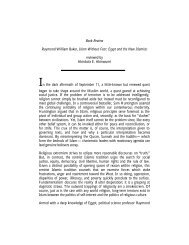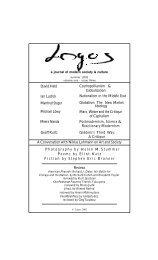Michael J. Thompson Stephen Eric Bronner Wadood Hamad - Logos
Michael J. Thompson Stephen Eric Bronner Wadood Hamad - Logos
Michael J. Thompson Stephen Eric Bronner Wadood Hamad - Logos
You also want an ePaper? Increase the reach of your titles
YUMPU automatically turns print PDFs into web optimized ePapers that Google loves.
Abbas Amanat<br />
golden age. The modern Shi’ite narrative of ’Ali’s pristine (though historically<br />
doomed) caliphate placed great moral emphasis on leadership qualities of<br />
compassion (walaya) and self-denial (ithar) essential for creating a “classless”<br />
society. Added to the admixture that concocted the “guardianship of the<br />
jurist” also was the modern revolutionary urgency for assertive leadership<br />
harking back to the French age of “terror” and the Russian “dictatorship of<br />
the proletariat.” Such presuppositions were barely conducive to a progressive<br />
legal framework that separates legal authority from political power and<br />
religion from the state. What profoundly was missing in this politico-legal<br />
vision of absolute leadership was a desire for re-examining the long-held<br />
precepts of Islamic law in a new light of historical relativity.<br />
As for the clerical community, in the two decades since the Islamic revolution<br />
it has allowed itself to be largely incorporated into the Islamic regime and<br />
actively sought to monopolize positions of power. A minority of the jurists<br />
remained critical of the theory and the implementation of leadership and<br />
faced the dire consequences of their criticisms. The rising opposition to<br />
wilayat-i faqih on the other hand unified the pro-regime clerics behind the<br />
doctrine and solidified the clerical hierarchy to an unprecedented degree. The<br />
Shi’ite establishment more than ever appears to be an equivalent of a statesponsored<br />
church with its ecclesiastical hierarchy, perhaps, as Said Arjomand<br />
observed, comparable to the Weberian “cesaro-papist” model of the state.<br />
The concentration of power in the hand of an oligarchy consisting of the<br />
guardian jurist and his top echelons of clerical allies, inevitably triggered<br />
much resentment. The laymen and laywomen of younger generation with<br />
revolutionary credentials now feel they have been left out by a clerical<br />
establishment that resorts to repression to preserve its privileges and<br />
monopolies.<br />
The anti-clerical content of Aghajari’s speech and his call for an Islamic<br />
Reformation originates in this pool of anti-clerical resentment. Younger<br />
Iranians are frustrated with the monopoly of power, heavy-handed treatment<br />
of dissident voices, and obscurantist legal outlook. They also are disillusioned<br />
with repeated setbacks of the seemingly pro-reform wing of the clerical<br />
establishment as represented by President Muhammad Khatami and his<br />
moderate clerical supporters. Such calls for reforming Islam are by no means<br />
rare in the history of antinomean Islam. Yet what distinguishes this postrevolutionary<br />
episode from earlier examples is that this movement of protest,<br />
especially since Khomeini’s death in 1989, aimed at a consolidated clerical<br />
hierarchy with claim to infallible and comprehensive authority. The<br />
<strong>Logos</strong> 2.3 – Summer 2003




